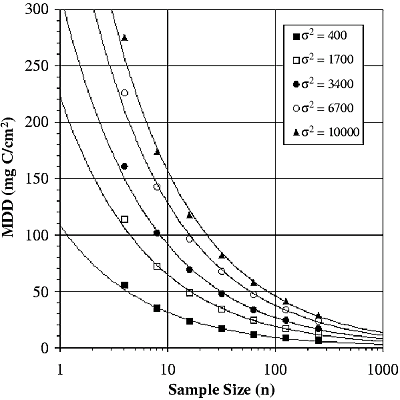2.4.2.3.3. Mineral soil horizons
The soil contains two major types of carbon: soil organic carbon and soil inorganic
carbon (which occurs primarily as carbonates). Although SOC constitutes the
majority of soil carbon in most soils globally (Batjes, 1996), soil carbon in
arid and semi-arid regions may be dominated by SIC (Schlesinger, 1982). In fire-prone
ecosystems, there may be significant amounts of charcoal present.
SOC held in the various layers, or horizons, of the mineral soil largely occurs
as humus. Much of the humus is adsorbed to the soil mineral fraction, particularly
to clay minerals (Richardson and Edmonds, 1987). A small amount of the total
content of soil organic matter consists of dead roots, which become part of
the soil organic matter upon their demise. In most cases, however, the amount
of carbon associated with such roots is <5 percent of the total carbon in the
soil profile (Ruark and Zarnoch, 1992).
There is a wide range of laboratory procedures available to measure SOC stocks,
the most accurate of which is dry combustion (usually performed using a carbon
analyzer). Changes in SOC stocks over a 5-year commitment period may be difficult
to measure in some soils because although they are potentially large in absolute
terms, they may be small compared with background levels (Batjes, 1999). Despite
these difficulties, the rate of change in SOC stock during a commitment period
can be measured (Lal et al., 2000); because of high spatial variability,
however, many sub-samples may be required to obtain a mean with an acceptable
standard error (Izaurralde et al., 1997; Garten and Wullschleger, 1999;
Post et al., 1999). Figure 2-9 (from Garten
and Wullschleger, 1999), for example, shows the calculated minimum detectable
difference in SOC as a function of variance and sample size for SOC changes
after 5 years under a herbaceous bioenergy crop.

|
|
Figure 2-9: Soil carbon inventories under a
bioenergy crop (Garten and Wullschleger, 1999).
|
In some cases, the cost of demonstrating the change in stocks to the required
level of accuracy and precision may exceed the benefits that accrue from the
increase in stocks. As the size of the stock change decreases, there will be
a point when the cost of demonstrating the change with sufficient confidence
exceeds the value of the carbon offset provided. The cost of demonstrating a
change in SOC stock could be decreased by developing and verifying locally calibrated
models that can use more easily collected data (Section
2.4.5).
|